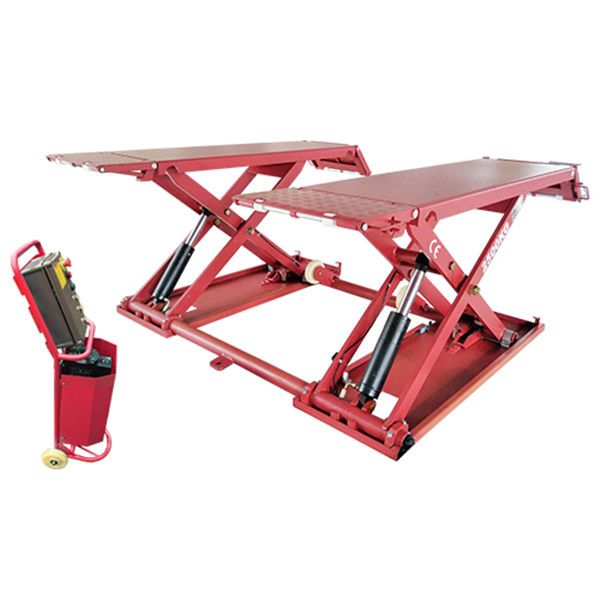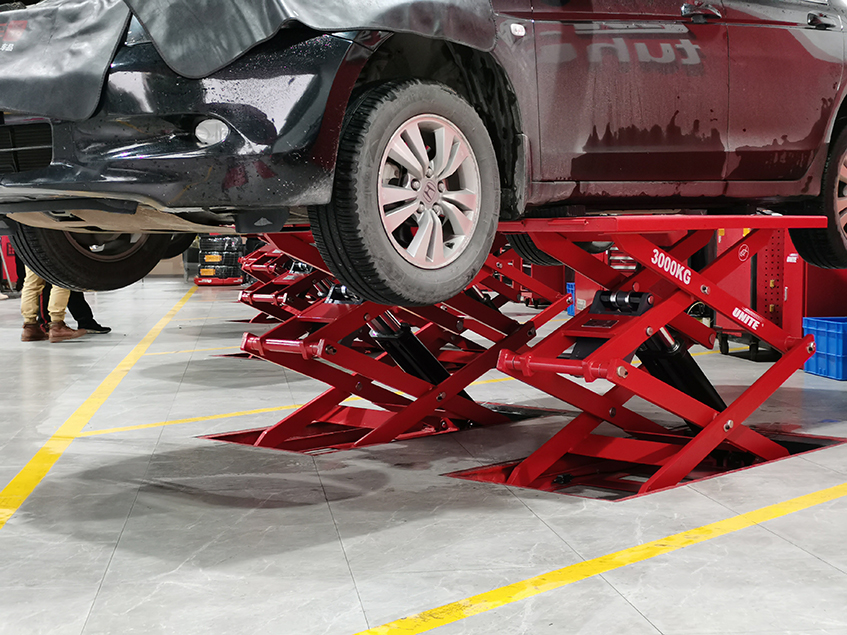If you’re in search of a practical car lift solution for your garage or automotive workshop, the mid-rise scissor car lift could be an excellent choice. These lifts offer versatility, making them ideal for garages with limited overhead space, as well as detailing shops and service bays.
In this blog post, we’ll delve into the importance of a mid-rise car lift for a wide range of automotive tasks. We’ll outline the types of jobs you can tackle with it and provide guidance on its safe and efficient setup and operation.
Why is a mid-rise car lift essential for an auto shop?
 A mid-rise car lift belongs to the category of scissor lifts, capable of elevating a vehicle to approximately 48 inches above the ground. This height clearance provides convenient access to various components under the vehicle, including the wheels, brakes, suspension, exhaust, and other undercarriage parts.
A mid-rise car lift belongs to the category of scissor lifts, capable of elevating a vehicle to approximately 48 inches above the ground. This height clearance provides convenient access to various components under the vehicle, including the wheels, brakes, suspension, exhaust, and other undercarriage parts.
In contrast to a full-rise car lift, which demands more space and a permanent installation, a mid-rise car lift offers the advantages of portability and easy storage. Equipped with casters, it can be effortlessly maneuvered around your garage or workshop and conveniently folded flat when not in active use.
Furthermore, this type of lift comes with a more budget-friendly price tag compared to a full-rise car lift, rendering it an excellent choice for both hobbyists and automotive professionals alike.
What types of tasks can you accomplish using a mid-rise car lift?
A mid-rise car lift can assist you in completing a range of tasks that might be challenging or unfeasible when relying solely on a floor jack or jack stands.
Consider these examples:
Tire Maintenance
Mid-rise car lifts make tire rotation and replacement a breeze by lifting all four wheels off the ground simultaneously. Additionally, you can easily check tire pressure, alignment, and balance using this lift.
Brake Servicing
This lift grants access to brake components like pads, rotors, calipers, and lines, allowing you to inspect, clean, and replace them without the need to crawl under the vehicle or remove the wheels.
Suspension Work
With a mid-rise car lift, you can efficiently address shocks, struts, springs, bushings, and other suspension parts. It facilitates adjustments to ride height, camber, caster, and toe.
Exhaust System Maintenance
This type of car lift empowers you to inspect and repair the muffler, catalytic converter, pipes, and hangers within the exhaust system. Furthermore, it facilitates the installation of a new exhaust system or alterations to the existing one.
Oil Change and Fluid Service
A mid-rise car lift simplifies the process of draining and refilling essential fluids like oil, coolant, transmission fluid, brake fluid, and more. You can also easily replace components such as the oil filter, air filter, fuel filter, and spark plugs with the assistance of a mid-rise car lift.
Setting Up and Operating a Mid-Rise Car Lift
While the setup and operation of a mid-rise car lift are straightforward, they do require careful attention. Here are the fundamental steps to follow:
- Select a level and stable surface for placing the car lift, ensuring there is adequate space for both the vehicle and your tools.
- Connect the power unit to an electrical outlet and attach the hydraulic hoses to the lift’s cylinders.
- Position the vehicle over the lift pads, ensuring the vehicle’s center of gravity aligns with the lift’s center. Use wheel chocks to prevent the vehicle from rolling.
- Press the ‘up’ button on the power unit to raise the vehicle. Pay close attention to any signs of instability or interference and stop when the vehicle reaches the desired height.
- Lock the safety bars on both sides of the lift, avoiding reliance solely on hydraulic pressure to secure the vehicle.
- Perform necessary work on the vehicle, utilizing jack stands or axle stands if support is required for any part not on the lift pads.
- Once the work is completed, lower the safety bars and press the ‘down’ button on the power unit to lower the vehicle. Remove the wheel chocks and safely drive the vehicle off the lift.
- Disconnect the power unit and hydraulic hoses, then fold the lift flat for storage in a dry and secure location.

